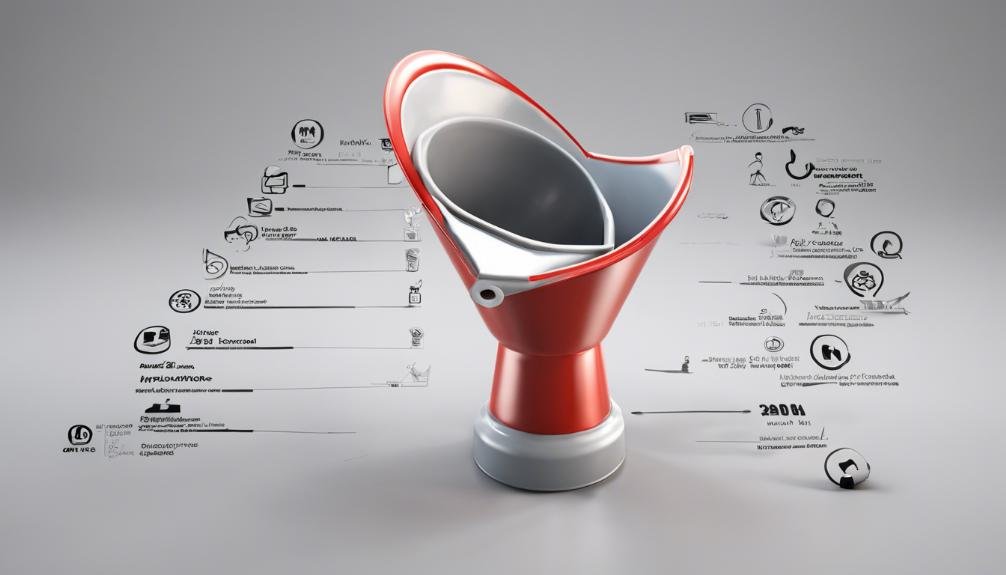Creating a Sales Funnel
To create a successful sales funnel, begin by understanding your audience deeply. Develop brand visibility and awareness to draw in potential customers. Capture leads effectively through targeted landing pages and engaging content. Nurture prospects by guiding them through the funnel with personalized communication. Focus on converting high-potential leads with tailored strategies. Close deals by addressing objections and showcasing your value. Upsell and cross-sell to maximize revenue and retain customers through exceptional service. Finally, analyze and optimize every step of the sales funnel for better results. Mastering the sales funnel process is essential for boosting conversions and revenue.
Key Takeaways
- Define your target audience and segment them appropriately.
- Create compelling lead magnets and effective landing pages.
- Implement email drip campaigns and lead scoring models.
- Focus on personalized nurturing and engaging content.
- Continuously analyze and optimize the sales funnel for conversions.
Understanding Your Audience
To create an effective sales funnel, you must deeply understand your audience's needs and preferences. This understanding is achieved through demographic research, psychographic analysis, consumer behavior insights, and market segmentation.
Demographic research involves gathering information about your audience's age, gender, income level, education, and other quantifiable characteristics. Psychographic analysis explores further into understanding their lifestyles, values, interests, and attitudes towards your product or service.
Consumer behavior studies how individuals make purchasing decisions, providing valuable insights into what drives their choices. By segmenting your market based on common characteristics or behaviors, you can tailor your marketing efforts to specific groups within your audience.
This targeted approach allows for more personalized messaging, leading to higher engagement and conversion rates.
Building Awareness
To build awareness effectively, you need to strategize on increasing brand visibility to reach your target audience. By implementing tailored strategies, you can guarantee your brand stands out amidst the competition and resonates with potential customers.
Identifying your target audience is pivotal for creating impactful campaigns that speak directly to the right people.
Brand Visibility Strategies
Improving brand visibility through targeted marketing campaigns is essential for building awareness and attracting potential customers to your sales funnel. Leveraging social media platforms can be a powerful tool in increasing your brand's visibility. By creating engaging content, running targeted ads, and interacting with your audience, you can enhance your brand's presence and reach a larger audience.
Additionally, forming partnerships with influencers who align with your brand can greatly boost visibility. Influencers have dedicated followers who trust their recommendations, making them valuable assets in spreading brand awareness. Collaborating with influencers to promote your products or services can help you tap into their audience and expand your brand's reach.
To maximize the impact of your brand visibility strategies, make sure that your messaging is consistent across all marketing channels. By maintaining a cohesive brand image and voice, you can strengthen brand recognition and credibility, ultimately driving more leads into your sales funnel.
Target Audience Identification
Identifying your target audience is an essential step in building awareness for your brand and attracting potential customers to your sales funnel. By conducting thorough demographic research and creating detailed customer personas, you can tailor your marketing strategies to resonate with specific consumer segments.
Market segmentation plays an important role in this process, allowing you to divide your market based on factors such as age, income, interests, and buying behavior.
Understanding buyer behavior is key to effectively targeting your audience. By analyzing how your potential customers make purchasing decisions, you can craft messaging and offers that appeal to their preferences and needs.
Customer personas help you visualize your ideal buyers, making it easier to create personalized marketing campaigns that speak directly to their motivations and pain points.
Capturing Leads
Enhance your lead capture strategy by implementing targeted landing pages on your website. Landing pages are essential in capturing leads effectively. Design these pages to be visually appealing, concise, and focused on a specific offer or message.
To entice visitors to share their contact information, consider incorporating a compelling lead magnet, such as an ebook, webinar, or free trial.
Optimize your landing pages by ensuring they're mobile-responsive and load quickly. A seamless user experience can greatly impact your lead capture rates. Use clear and persuasive call-to-action buttons to guide visitors towards providing their details.
Utilize forms with a minimal number of fields to reduce friction in the sign-up process. The easier it's for prospects to subscribe, the higher the chances of them converting into leads.
Implement A/B testing to refine your landing pages continuously and improve conversion rates.
Nurturing Prospects
To effectively move prospects through your sales funnel, consider implementing Email Drip Campaigns to provide valuable content and stay top of mind.
Utilizing a Lead Scoring Model can help prioritize leads based on their engagement level and readiness to make a purchase.
These strategies aim to nurture prospects, guiding them towards conversion and maximizing your sales potential.
Email Drip Campaigns
Engage your potential customers through a series of automated emails strategically designed to nurture and guide them through the sales funnel. Email personalization is key to capturing the interest of your leads.
Utilize automation tools to schedule and send targeted content based on the prospect's behavior and preferences. By incorporating the recipient's name, company, or specific details related to their interactions with your brand, you can create a more personalized experience that resonates with the individual.
Tracking engagement metrics is vital to understanding the effectiveness of your email drip campaigns. Analyze open rates, click-through rates, and conversion rates to refine your messaging and optimize the customer journey.
Conduct A/B testing to experiment with different subject lines, content formats, and call-to-action buttons to determine what resonates best with your audience.
Crafting a well-thought-out email drip campaign can have a significant impact on the success of your sales funnel by nurturing leads and guiding them towards conversion. Keep refining your approach based on data and insights gathered from engagement metrics to continuously improve the effectiveness of your email strategy.
Lead Scoring Model
Utilize a well-defined lead scoring model to effectively identify and prioritize prospects based on their engagement levels and readiness to convert, streamlining your sales efforts and maximizing efficiency. Establish clear scoring criteria to evaluate prospects' interactions with your brand, such as website visits, email opens, whitepaper downloads, and webinar attendance. By assigning numerical values to these actions, you can objectively measure a prospect's interest and intent to purchase. Implement lead qualification techniques like demographic information, company size, and job title to further refine your scoring model and guarantee alignment with your ideal customer profile.
Segment prospects into different categories based on their scores, such as hot, warm, and cold leads, enabling your sales team to tailor their approaches accordingly. Focus your resources on nurturing hot leads who exhibit high engagement levels and are more likely to convert, while also implementing targeted strategies to warm up colder leads.
Continuously analyze and adjust your lead scoring model to improve its accuracy and effectiveness in identifying valuable prospects that are primed for conversion.
Converting Leads to Customers
Maximizing your conversions from leads to customers requires a well-defined strategy and consistent follow-up. To effectively convert leads into customers, you need to guide them through the sales funnel, ensuring a seamless customer journey. Start by understanding your target audience and tailoring your communication to address their needs and pain points. Utilize lead scoring models to prioritize leads based on their likelihood to convert, focusing your efforts on those with the highest potential for customer acquisition.
Implement personalized and timely follow-up strategies to nurture leads and move them further down the sales funnel. By providing valuable content, addressing objections, and offering solutions, you can build trust and credibility with your leads, increasing the chances of conversion. Utilize various channels such as email marketing, social media, and targeted advertisements to engage with leads at different touchpoints along their customer journey.
Consistent communication and strategic engagement are key to converting leads into customers successfully. By optimizing your lead conversion processes, you can enhance your customer acquisition rates and drive business growth.
Closing the Sale
To successfully close a sale, you must strategically address the customer's needs and objections while emphasizing the value proposition of your product or service. When handling objections, it's essential to listen actively to the customer's concerns and address them with confidence. Utilize effective negotiation tactics by highlighting how your product or service resolves their specific pain points.
Crafting a compelling sales pitch is important in capturing the customer's interest and driving them towards a purchase decision. Clearly articulate the benefits and unique selling points of your offering to demonstrate its value. Employing closing techniques such as the assumptive close or the summary close can help guide the customer towards making a commitment.
Upselling and Cross-selling
Enhance your sales strategy by implementing effective upselling and cross-selling techniques to increase the value of each customer interaction. By mastering these strategies, you can't only maximize your revenue but also enhance customer satisfaction and loyalty.
Product bundling is a powerful way to increase the average order value by offering complementary products together at a slightly discounted price. This technique not only encourages customers to purchase more but also helps in showcasing a wider range of your offerings.
To foster customer loyalty, consider providing value-added services that go beyond the basic product purchase. This could include extended warranties, free shipping, or exclusive access to premium content. These added perks can make customers feel valued and more likely to return for future purchases.
Personalized recommendations based on a customer's purchase history and preferences can significantly boost sales. By showing customers products that align with their interests, you create a tailored shopping experience that's more likely to result in additional purchases.
Mastering these techniques won't only increase your revenue but also solidify relationships with your customers.
Retaining Customers
Implementing effective customer retention strategies is essential for sustaining long-term profitability and fostering loyalty within your customer base. Customer loyalty is a valuable asset for any business, as it not only generates repeat sales but also leads to positive word-of-mouth referrals.
To enhance customer loyalty, consider implementing personalized communication strategies to make your customers feel valued and appreciated. Offering exclusive deals, discounts, or loyalty programs can also incentivize repeat purchases and strengthen the bond between your brand and customers.
Retention strategies should focus on providing exceptional customer service, promptly addressing any issues or concerns, and continuously seeking feedback to improve customer experience. By actively engaging with your customers and showing genuine interest in their satisfaction, you can build trust and loyalty over time.
Additionally, leveraging data analytics to understand customer behavior and preferences can help tailor your offerings to better meet their needs, increasing the likelihood of repeat business and long-term customer retention. Remember, investing in customer retention is a strategic approach that can yield significant returns in the form of sustained profitability and a loyal customer following.
Analyzing and Optimizing
By analyzing key metrics and optimizing your sales funnel, you can identify areas for improvement and drive increased conversions effectively. One important metric to focus on is the conversion rate, which reflects the percentage of visitors who complete a desired action, such as making a purchase. By closely monitoring this metric at each stage of the funnel, you can pinpoint where potential customers are dropping off and take targeted steps to address any bottlenecks.
A/B testing is a powerful tool in this optimization process. By creating variations of your sales funnel elements and testing them against each other, you can determine which version performs better in driving conversions. This data-driven approach allows you to make informed decisions based on real user behavior rather than assumptions.
Continuously analyzing and optimizing your sales funnel based on these key metrics and A/B testing results will help you fine-tune the customer journey and maximize conversion rates. Remember, small tweaks can sometimes lead to significant improvements in your overall sales performance.
Frequently Asked Questions
How Can I Effectively Measure the ROI of My Sales Funnel?
To effectively measure the ROI of your sales funnel, start by implementing robust tracking mechanisms. Analyze conversion rates meticulously and focus on optimizing each stage. This strategic approach will provide valuable insights for your ROI analysis.
What Are Common Pitfalls to Avoid in Sales Funnel Implementation?
When implementing a sales funnel, you should steer clear of common mistakes like overlooking customer touchpoints, neglecting lead nurturing, and not continuously optimizing the process. Focus on avoiding pitfalls and implementing best practices for peak results.
How Do I Adjust My Sales Funnel for Different Target Demographics?
When adjusting your sales funnel for different target demographics, focus on targeting strategies and market segmentation. Customize content to align with consumer behavior. Remember, "Different strokes for different folks." Tailoring your approach enhances engagement and conversion rates.
Can I Automate Parts of My Sales Funnel for Efficiency?
To maximize efficiency in your sales funnel, consider automating processes. By streamlining tasks like lead nurturing, email follow-ups, and customer segmentation, you can save time and resources while maintaining a personalized touch.
What Strategies Can I Use to Re-Engage Lost Leads in the Funnel?
Lost leads in the funnel need a strategic approach. Engage through targeted email campaigns and follow-up calls. Offer personalized content and incentives to reignite interest. Create a connection that resonates, leading them back to conversion.
Conclusion
To wrap up, establishing a sales funnel is like constructing a well-oiled machine that guides potential customers through every step of the buying process.
By understanding your audience, building awareness, capturing leads, nurturing prospects, and ultimately converting them into customers, you can drive sales and grow your business effectively.
Remember to analyze and optimize your funnel regularly to guarantee maximum efficiency and success. Keep refining your strategy like a sculptor shaping a masterpiece, and watch your sales soar.








